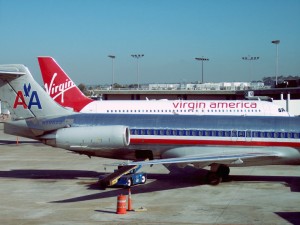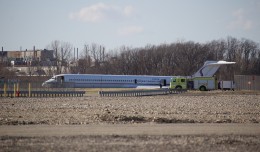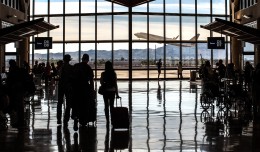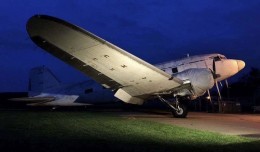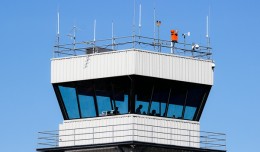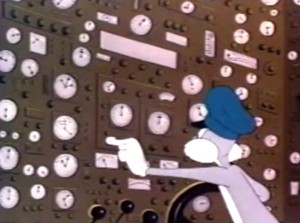 For many of us, our first understanding on how to start an airplane was when Bugs Bunny started the engines of the “World’s Largest Airplane” in Hare Lift (FF to 2:04). With a simple push of a button, all of the radial engines were up and running. And as ridiculous as that was, in the sixty years since, starting the modern jet engine has become just as simple as that.
For many of us, our first understanding on how to start an airplane was when Bugs Bunny started the engines of the “World’s Largest Airplane” in Hare Lift (FF to 2:04). With a simple push of a button, all of the radial engines were up and running. And as ridiculous as that was, in the sixty years since, starting the modern jet engine has become just as simple as that.
In the Beginning
A century ago when the Wright brothers started up the four cylinder engine on the Wright Flyer, they did so by hand. This was the method for the farm tractors, motorcycles, and automobiles of the time, as the electric starter was still several years away. Even had the Wright brothers had access to an electric starter, they likely would have rejected it to keep the weight and complexity of the Wright Flyer to a minimum.
Even after the electric starter became available, during the several decades following the Wright’s flight, the majority of the airplanes produced chose to reject the heavy and expensive electric starter and relied on the pilots hand propping their new airplanes. Though it seems to be highly dangerous, it is a safe with proper training.
When hand propping an aircraft, the person outside is the one in control, though the pilot will typically direct the sequence. The engine will then be turned over several times with the ignition off to purge the cylinders of stale air and oil, which is especially critical on radial and inverted engines. Gasoline will then be either poured directly into the intake manifold, or injected with a small hand pump in the cockpit. The person propping then checks the security of the brakes by pulling and pushing on the propeller then calls “Contact!” instructing the pilot to turn on a magneto. The term Contact is often used to better differentiate between the calls of having ignition system on or off; Contact is used to denote Magneto or Mag On, and not to be confused with Mags Off.
The propeller would then be pulled through one compression stroke at a time with the magneto on. When the engine started, the pilot would then resume control of the airplane; adjusting the throttle for proper idle, switching on a second magneto, checking oil pressure, and completing the start procedure from memory.
Here is a great video of someone hand propping a 985 cubic inch radial, safely and without theatrics.
The biggest risk, especially with these older engines, was fire. Extinguishing bottles were kept near, and were often at the ready in the hands of an additional person. Airlines made this standard procedure and often retained it moving into the jet age out of habit and not out of necessity as the new turbine engine’s risk of fire wasn’t related to the start sequence.
Eventually the piston aircraft engines became too large to hand prop or were mounted in locations which made it impossible to safely hand prop. Though electric starters were now available for smaller engines, they had not evolved to the point at which they could be used start engines that were much more than a couple of hundred cubic inches in displacement. The answer was a flywheel that was brought to speed by a hand crank or electric motor, and then engaged by a clutch to the engine. The distinctive sound of the inertia starter and the radial engine became a staple for Hollywood’s war movies. Eventually these heavy inertia starters were replaced with powerful electric starters, and are rarely found today even on those airplanes that left the factory with them installed.
Starting the Jet Age
The jet engine came into use at the conclusion of World War 2. Starting this new engine was distinctly different than the piston engines it was replacing. Though the risk of a fire is almost entirely eliminated during the start sequence, the engine could quickly be destroyed by overheating from the blundering hand of a pilot or flight engineer.
Unlike the piston engine, prior to fuel being introduced, the jet engine must be spun up to several hundred or several thousand RPM by a starter. A small fuel flow is introduced into the engine by the pilot or flight engineer, and igniters similar to those on gas stovetops will commence the combustion of the vaporized jet fuel. The exhaust gas temperature gauge will indicate “light-off” with an increase in temperature. This gauge and the RPM gauge will be closely monitored during the start. If the temperature is rising too quickly, or if the RPM does not increase quickly, or if there is no increase in temperature, the start will be aborted. During a normal start, the starter and the energy released from combustion will continue to accelerate the engine.
If the start goes well, the fuel flow will be advanced to the idle setting and the RPM will stabilize around 35% of the maximum RPM. At this point, the starter will be disengaged, the generator turned on, and the checklist completed. If the start did not go well, the engine will continue to be spun by the starter to purge any excess heat or unburnt fuel. After letting the starter cool, a second attempt to start the engine will be made unless component failure or damage is suspected. Normal starts are the routine, but occasionally there will be a problem starting the turbine engine.
If there is inadequate force from the starter or burning fuel, the engine RPM will stabilize below the idle setting with the temperature continuing to rise. This is called a hung start, and after recognizing it, the fuel will be cutoff, shutting down the engine. After letting the starter cool, a second attempt can be made.
If the fuel flow is advanced too quickly, or there is a malfunction in the fuel controller, the temperature during the start will rise more rapidly than normal. If it is approaching the limit, the fuel will be cutoff shutting down the engine. This is a hot start, and if it was human error, a second attempt might be made. If the fuel flow was out of control or the temperature limitation was exceeded, the engine will require maintenance or inspection.
Like the large radials they replaced, the early jet engines were difficult to start, temperamental, and often had a dramatic display of smoke and fire in the tailpipe during a routine start. Occasionally there would be a small dribble of fire or torch from fuel that had not ignited in the burner cans but had pooled in the tailpipe prior to light off. The Rolls Royce engines were especially known to smoke during start, and often prolifically during cold weather.
The first turbojets were brought up to speed during the start by electric motors that became generators at the completion of the start cycle. As the size of the turbojet engine increased, the electric motor quickly became inadequate to accelerate the engine to minimum starting speeds. The electric motors were replaced with air turbine starters that use high volume compressed air from either an external cart, another engine, or now commonly the plane’s Auxiliary Power Unit (APU). Additional benefits of this type of starter include it being more reliable and that it can run for longer periods of time before overheating. The electric starter remains commonplace on small turbojet engines on corporate jets as well as on most turboprop and turboshaft (helicopter) engines.
The manual fuel controllers of the first engines were soon replaced with fuel controllers that automatically regulated the fuel flow during start sequence, allowing the flight engineers and pilots to pay full attention to the RPM and temperature gauges and eliminating the bumbling hand of those who are poorly trained or focused. Automation was soon adapted to the starters and generators, disengaging them and engaging them automatically at specific points during the start sequence.
That basic level of automation has since been replaced by fully automatic engine controls that can start the engines with a simple push of a button, and requiring nothing further from the pilots. If problems in the start sequence arise, the system will even abort the start and alert the crew to the problem. At the completion of the start; the engine along with the electrical, pneumatic, and hydraulic systems will be ready for flight. In the passenger compartment, a smooth uninterrupted and seamless hum during the start indicates this high level of automation.
Generally, people complain about the aft most seats in the MD-80, however these seats (with either no window or a view of the cowl) offer the aviation enthusiast clear audible indications of each step of the start sequence, especially when seated on the right side.
When the aircraft is being pushed back from the gate, the APU will be providing both the electrical and pneumatic power for the airplane. Once given clearance to start engines, the pilot will then turn on an engine’s ignition and reroute the pneumatic power from the air conditioning to the engine’s air turbine starter. This is indicated by a dramatic reduction in airflow the cabin, followed by a very faint shhhh sound as the air flows to the air turbine starter. That shhhh sound is immediately overpowered by a growl as the engine begins to rotate and accelerate. After a few seconds, the engine will stabilize around 25% (of the maximum RPM), indicated by a steady hum replacing the growling. The pilot will then turn on the fuel flow and a plume of vaporized jet fuel with enter the engine’s burner  cans. When this plume reaches the igniters, it will light-off and create a poof sound. The engine will resume accelerating with a grinding sound and slowly replaced by a whine as the RPM increases. At 40% RPM, the airplane will automatically switch from the APU to the engine’s electrical power as indicated by a flash of the interior lights and tone from the PA system. This also indicates when the air turbine starter has disengaged by the pilot and the engine is now continuing to accelerate on its own. At the completion of the start cycle, the RPM will stabilize at 55%. The pilot will then either start the second engine or more commonly, plan to taxi out with the one engine running as indicated by a resumption of the air-flow from the air conditioning. A similar sequence can also be heard inside the cabin of the Boeing B737-300/400/500, but not as clearly due to the wing mounted engines.
cans. When this plume reaches the igniters, it will light-off and create a poof sound. The engine will resume accelerating with a grinding sound and slowly replaced by a whine as the RPM increases. At 40% RPM, the airplane will automatically switch from the APU to the engine’s electrical power as indicated by a flash of the interior lights and tone from the PA system. This also indicates when the air turbine starter has disengaged by the pilot and the engine is now continuing to accelerate on its own. At the completion of the start cycle, the RPM will stabilize at 55%. The pilot will then either start the second engine or more commonly, plan to taxi out with the one engine running as indicated by a resumption of the air-flow from the air conditioning. A similar sequence can also be heard inside the cabin of the Boeing B737-300/400/500, but not as clearly due to the wing mounted engines.
In the century of aviation since the Wright brothers took flight, starting an aircraft engine has gone from being a dangerous, complicated affair to a simple push of the button. And although the “World’s Largest Airplane” never became a commercial success, the push-button automated starting system has become a staple of the modern jet airliner.
David J. Williams is a former airline Captain and currently involved with aviation safety.
Grumman Goose photo courtesy RuthAS. Used under the terms of the Creative Commons Attribution-Share Alike 3.0 Unported license.




